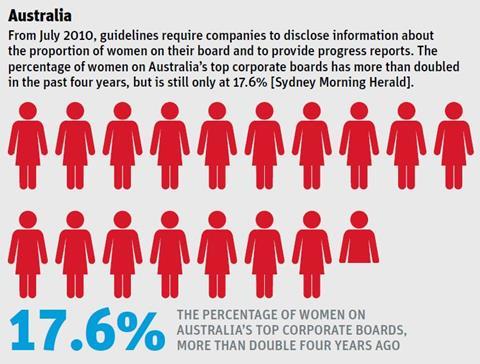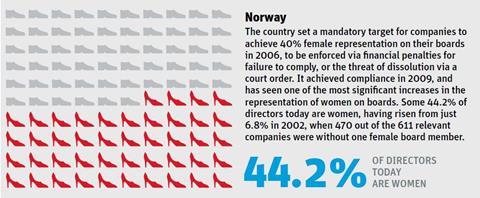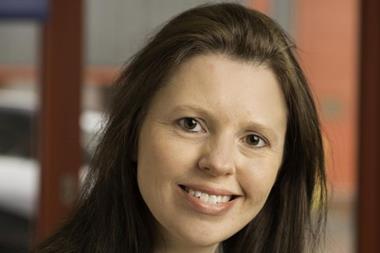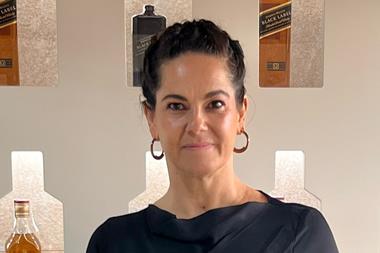The world is watching you. That was the stark warning to British business at the release of the Female FTSE Board Report in March 2014, which detailed the progress top listed companies were making toward gender diversity on their boards.
“The world is watching to see whether British business can deliver real change by voluntary means,” the foreword read. And failure to do so will lead to renewed pressure from the EU “to enact their compulsory measures”.
“Targets are good. We have targets for profits, targets for costs, targets for paper clip consumption, why wouldn’t you have targets for talent?”
In other words, make a concerted effort to improve gender diversity on boards or it will be imposed upon you. So has the fmcg industry taken this warning seriously? Or are diktats from Brussels, demanding the appointment of female bosses, now inevitable?
Within the framework of the report, current progress towards a target set by Lord Davies in 2011, which requires 25% women on the boards of the FTSE 100 companies by 2015, appears promising. Indeed, as of March 2014, of the 19 fmcg companies, made up of four retailers and 15 brands, manufacturers and suppliers, 48 of 206 (or 23%) of board members were women. That puts fmcg ahead of the cross-sector average of 20.7%, a figure that has since increased to 22.8% according to an updated report from the Department for Business, Innovation & Skills. It also puts it on a trajectory to hit the 25% target this year.
Diageo leads the way, ranking joint first for gender diversity alongside outsourcing giant Capita, with a representation of 44% women on its board. The next fmcg companies on the list are Unilever with 36%, and GSK with 33%. “It’s clear that the Lord Davies report has been super-helpful in focusing attention on really driving gender diversity, and on businesses doing it for themselves,” observes Emily Lawson, group human resources director at Morrisons. “It’s been an extraordinary sea change without a need to put quotas in, and without the need to legislate about it.”
However, as Lawson adds, though the “stature and influence” of focusing upon the FTSE indexes is useful in highlighting the issue, a look beyond the narrow framework of the report reveals a far less rosy picture.
Thinly stretched
According to a 2014 study by consulting group Norman Broadbent, in which data was collected from more than 1,700 listed companies, the 87 consumer goods manufacturers had, on average, 14% women on their boards (the report also said the 57 retailers had 19%, but it didn’t split out the grocers.)
At 14%, consumer goods is ahead of the cross-sector average of 11%, but still falls well short of the 25% target Lord Davies believed was “achievable” as a “minimum” for its larger peers. So why the gap between the FTSE 100 and the remaining listed companies?
For Kate Latham, managing director for retail, leisure and consumer at Norman Broadbent, although a public scrutiny focused on the top firms is perhaps a “contributing factor” to lapsed progress at lower levels, there are other factors at play.
These include a flurry of new entrants to AIM, a sub-market of the London Stock Exchange, at the start of 2014 when “an IPO frenzy” saw a number of companies “quickly formulate boards”, using existing networks without an objective process, made up of primarily male candidates. The typically smaller size of boards in both AIM and fledgling companies also left less opportunity for new recruits.
Perhaps more significant is Latham’s view that across all listed business “we have got to a little bit of an inflection point, in which a lot of the women who are experienced on boards are now absolutely at full capacity.”
Effectively, she means the progress of fmcg towards gender diversity can largely be attributed to a small pool of highly experienced women appointed to multiple, part-time, non-executive directorships on boards. So female talent at the top isn’t necessarily growing, it’s simply being thinly stretched.
The fact these women are mostly in non-executive positions also matters because the “majority of power” is held by an executive team responsible for the day-to-day management of a company rather than the non-executives responsible for “overseeing the actions of management,” adds Lawson. “So the question on everybody’s mind is filling the executive pipeline so you’ve got the next generation of women for boards.”
According to the Norman Broadbent study, just 8.1% of executive roles on fmcg boards are taken up by women, and 8.2% in retail, with Alison Cooper of Imperial tobacco the only FTSE 100 CEO of an fmcg company. That leaves the sector behind health, investment, the media, and the service industry in appointing women to executive positions.
Even where women are reaching executive status, they are being appointed to HR, communications or marketing roles, which typically do not lead to CEO positions, says Karoline Vinsrygg, co-head of global diversity at Egon Zehnder, a leading executive search firm. Indeed, the authors of the apparently promising Female FTSE Board Report admit “achievement of the 25% target for women on boards is undermined by failure to pull women through to top executive roles”.
Progressive
The business case for plugging the gaps in this leaking executive pipeline is all too clear. According to the Lord Davies report, companies with more women on their boards outperform rivals with a startling 42% higher return in sales, a 66% higher return on invested capital and a 53% higher return on equity.
It is a correlation between diversity and performance that comes as little surprise to president and CEO of Walmart’s EMEA region Shelley Broader, who oversees more than 285,000 members of staff across 1,345 stores.
“It’s no secret that the most successful companies have diverse senior management teams. It makes business sense,” says Broader, who works alongside former Asda chief operating officer Judith McKenna, who Walmart promoted to its COO in December.
“Over my career I’ve seen talented women aligning themselves to organisations that value diversity - they want to be with a company that really gets it. The companies that don’t are missing out.”
It is an economic argument especially pertinent for fmcg, with women responsible for 70% of household purchasing decisions, according to a study by investment managers TCAM and The Observer. So appointing more women to the boards of fmcg companies is “vital” argues Tania Howarth, COO at Iglo Group. “If the thinking inside an organisation doesn’t mirror the thinking and behaviour of their consumer base, I fail to see how that organisation can win.”
Research from Credit Suisse that examined companies across more than 40 countries also found that in companies specialising in consumer essentials, those with less than 10% of women on their board had a return on equity of 13%, compared with 18% for companies where women accounted for between 10% and 15% of board members.
Clear numbers, then, but a lack of awareness of this “performance tick” is not what is holding the industry back, believes Lawson. “I don’t think that the business case is poorly understood. I think the UK’s FTSE 100 and 250 chairmen are quite savvy, and quite clear that it’s the right thing to do,” she says.
So what is stopping more women ascending to the top? “Primarily it’s a mindset issue,” says ABI Marchant, HR director for Danone Waters UK & Ireland and Danone UK Dairies, at which 52% of board level positions are taken up by women. She believes many companies are too rigid and inflexible when it comes to employees and if “too many barriers exist to allow a talented member of staff to progress, it won’t remove those barriers”.
Marchant believes “progressive” companies like Danone understand that the double burden of work and family life is a critical component in the retention of talented women. As a result it has moved away from the perspective that the two are “mutually exclusive”, and instead treats them as “interdependent”. She says 20% of Danone’s UK employees don’t work classic contractual hours and adds she is “surprised” at the slow pace of change in this respect elsewhere.
Certainly when Morrisons recently restructured its management, Lawson says it was “clear there was a possibility of losing some really good women in the process”, so job descriptions were amended to allow more flexible working hours and the potential for job shares. Consequently, the supermarket has seen an increase in the percentage of its female managers, compared with before the restructure.
However, Broader is quick to add that the option for flexible working is one that should be extended regardless of gender. “If the men in the same office aren’t given the same opportunity - like the dad sitting at his desk wishing he was at his daughter’s school play - we’re no further forward. This is about inclusion and flexibility for the entire workforce.”
However, Professor Susan Vinnicombe, leadership director of the International Centre for Women Leaders and one of the authors of the Female FTSE Board Report, warns that although flexible working is “significant”, it “isn’t the issue. We kid ourselves if we think it is. There are plenty of women who don’t have children, who don’t get developed and who don’t get to the top.”
Vicious cycle
Indeed, the notion that most women simply disappear to start a family is a myth that can quickly be dispelled. According to charity OnePlusOne, 68% of UK mothers continue to work after having children, while KPMG’s gender diversity study Cracking the Code revealed that the disparity in promotions between women with children and those without is minor, with both falling far short of their male counterparts.
So who is to blame? One factor is that women can fail to pick up P&L responsibilities at “crucial points” in their careers, admits Professor Vinnicombe, but she also detects the existence of “unconscious bias” among senior executives, predominantly men, promoting those who mirror their own leadership traits.
It’s a view shared by recruitment policy advisors Catalyst Europe, which says the situation creates a “vicious cycle” where men continue to dominate executive positions. And it’s another obstacle to progress that Howarth has seen in her own career, which has also spanned roles at Coca-Cola, PepsiCo and Walkers.
“There is sadly still a lot of assumption-based decision making in organisations when it comes to people decisions,” she says. “Culture plays a part” as does valuing “leadership impact or presence”, “networking” or “advocacy”, which are much “harder to define” but typically “favour typical male-style types”.
To combat this cultural bias, some companies have sought to objectify their recruitment criteria. For instance, Morrisons is looking to roll out its unconscious bias awareness training for all interviewers, as well as bolstering selection processes by requiring consideration of at least one female candidate, one person for whom the role would be a step up, and one person for whom it would be a horizontal move.
Meanwhile, senior leaders at Asda have also attended upskill training with Global Diversity Practice on the impact of unconscious biases upon decision making.
Setting clear targets for gender diversity at all levels of a company is a vital part of the solution, too, believes Fiona Hathorn, managing director of Women on Boards UK. “Targets are good business management. We have targets for profits, targets for costs; we have targets for paper clip consumption. Why wouldn’t you have targets for your talent?” she says.
Indeed, a survey of more than 1,000 women carried out by the group found that 80% agreed with gender targets, albeit for public sector boards and committees, and that 75% believed the issue was significant enough to sway their vote in the general election. A target-driven approach is simply “good business management,” says Hathorn. “You turn off the spotlight on the people you know, and you turn the floodlights on the whole of England and take a look around,” she adds.
That’s been the approach taken by industry success stories. Diageo (which has Deidre Mahlan as CFO) wants at least 30% of women in senior leadership roles by 2020; Unilever (which has Jane Moran as CIO) is targeting 50% of its managers to be female; and GSK exceeded its goal to have more than 25% female board representation by 2013, with women now accounting for 33%.
Yet whenever quotas and targets are on the table, so are fears of tokenism. Marchant, who accepts that targets can be a “catalyst for change”, asks: “How does it feel to be a woman working in a business that hasn’t changed its mindset but has been asked to implement a quota?”
And Howarth says that as a younger woman she “hated the idea of quotas, mostly because I believe in meritocracy and at a personal level I wanted to earn a promotion on merit. But sadly not enough has changed in the last 30 years. I believe that subconscious bias in decision making and typically male cultures are in part stifling progress. Therefore targets and quotas are inevitable if organisations genuinely want to change.”
Punitive measures
If they don’t, the decision may soon be taken out of their hands. Reacting to the Female FTSE Board Report last year, MP Gloria De Piero, Labour’s shadow minister for women and equalities, warned that without “sufficient progress” to increase the numbers of women on boards, the party would “consider introducing more prescriptive measures, such as quotas”.
De Piero says there are no plans for such mandatory targets to be enforced via financial penalties, but stands by the need for government to see “real progress” being made to boost numbers at both the exec and non-exec levels. “No one likes quotas, but they were needed to finally shake this place up, and the idea that any of the women elected on them isn’t as talented as their male colleagues is quite frankly absurd,” De Piero adds.
Proposals for an EU-wide framework that would require a mandatory quota of 40% of non-executive directorships to be held by women by 2020 for listed companies also remain on the books, with the European Commission suggesting failure to comply would invoke fines or other punitive measures.
“Our target is in sight,” business secretary Vince Cable told a Women in Business event in London earlier this month. But he also added: “If we are to avoid action from Brussels, we must continue to demonstrate that our voluntary approach is the right one, and that it is working.”
Fmcg should consider itself warned.
Diageo

Since the Female FTSE Board Report in March 2014, in which Diageo ranked joint first for the gender diversity of its board, it has further boosted its female board members, who now account for 45.5% of the total.
Cherie Sheridan, organisational effectiveness director, says: “At Diageo we truly champion diversity in the workplace and believe that gender diversity and our inclusive culture give us a competitive advantage.
“We are proud that over 40% of our board members, 40% of our executive committee and more than 25 of our senior leadership roles at Diageo are held by women.
“Our flexible working policies are evolving and being more effective. We offer the ability to work part time, or indeed job share, the option of home working, and also compressed hours.”
























No comments yet